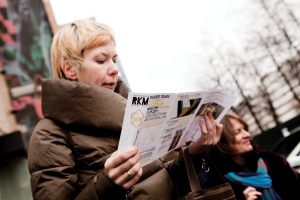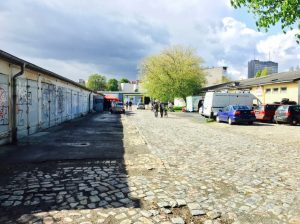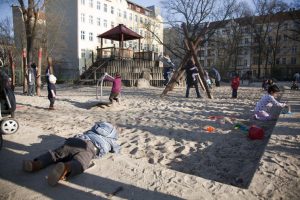The former glass factory located in Lausitzer Straße 10/11 in Berlin-Kreutzberg is a domestic community that best embodies the prototype of the so-called "Berlin mix", whereby available spaces are equally distributed to allow for both their residential and commercial use.
Similarly to other cases in the Berlin-Kreutzberg, the Lause has been threatened by the possibility of an unaffordable rent increase due to the intention of the owner to sell the building to the highest bidder. The complex has been used for both residential and commercial uses, and its inhabitants vary from families, to craftspeople, from artistic collectives to political initiatives, whose work is deeply rooted in the neighbourhood’s fabric. Following the threat of being displaced from their home, the Lause community understood that in order to contest gentrification they needed to collectively self-organise. Based on principles of solidarity and community building, they engaged in a journey marked by the frenetic and chaotic rhythm that tight schedules and exhausting negotiations impose. After more than 5 years of struggle, the Lause was successfully saved, as in 2022 an agreement was reached allowing the Berlin municipality to buy back the property. Now, the Lause is able to maintain its status as an open and non-commercialized space at the neighborhood’s disposal without being threatened by further risks of displacement, as a lease was recently signed granting the residents with a free use of the estate for 65 years. Today, the buildings host relevant and politically active organizations, such as the anti-fascist educational center Apabiz, the video platform Leftvision, the Umbruch Visual Archive, and the Black German Heritage Association. The Lause is therefore a hive around which families, craftsmen, artists, and ONGs have structured their everyday routines along a tight-knit network of friendship and cooperative ties, slowly built over years of interactions and supportive exchanges.
The complex represents a model project for the urban development of the city of the future as ordinary residents envision it; the central issue for the Lause community is not owning that space, but rather creating and having free access to opportunities to best engage with it. As in many other cases in contemporary Berlin, however, it had to embark on a journey of frenetic mobilization in order to save its status as an open and non-commercialized space at the community’s disposal.
The complex has, in fact, just come out of years of struggles and negotiations opposing modern forces of privatization and financialization, which expose urban territories and their inhabitants to the risk of displacement in favor of profits that come from the sale of privately owned estates to the highest bidders. In 2007, the Lause was sold to Tækker – a Danish group of investors – and since then the threat of further lucrative transfers of the property has always been latent. Indeed, in 2016 the residents discovered Tækker was about to sell the Lause for the price of 20 million euros, profiting from an increase of 800% compared to the original investment made when they bought it from the Berlin municipality (i.e., 2.3 million).
The transformation of the Lause’s spaces into luxury flats would have meant an unsustainable rental boom in the area, thus the end of the community project being realized by its residents, who would have had probably to relocate away from Kreuzberg-Friedrichshain where the effects of gentrification were already tangible. Refusing to surrender to such threat, the people of Lausitzer Straße 10/11 self-organized into a structured association, the “Lause Leben” initiative, which immediately started to work for the preservation of the housing facilities and the rights of the neighborhood to freely access them. Political actions and several protests were staged to advance such claims, and the State of Berlin was pressured to buy back the estate from Tækker in order to put speculative activities to a halt. After years of struggle, such mobilization bore its fruits, as in early 2022 the Danish group agreed to settle for a selling price of 11 million euros, allowing the Lause community to sign a 65-year lease on the property.
Tesserae included the Lause as a focused case study within the framework of the Co-creation H2020 project funded by EU Marie Curie RISE and led by Oxford University, in collaboration with other six organizations scattered around Europe and Latin America.


